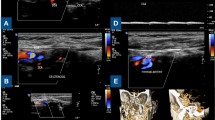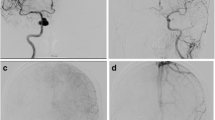Summary
Protracted studies on bilateral internal carotid artery (ICA) flow using implantable electromagnetic flow probes were performed in ten patients undergoing graded occlusion for infraclinoid saccular aneurysm. The ICA flow was generally lower on the side of the aneurysm in the eight patients with previous subarachnoid haemorrhage, and the difference was statistically significant at the 5% level. This was attributed to the increased vascular resistance in the affected hemisphere. A contralateral ICA flow increase, varying between 14 and 73%, was found in all patients at test occlusion of the ipselateral ICA.
Three patients showed electro-encephalographic evidence of intolerance to clamping of the artery. They also showed the lowest contralateral compensatory increase (14–17%) at test occlusion. Furthermore, a delay in contralateral flow response to stepwise trial occlusion was observed in these patients. Two of these patients suffered ischaemic attacks in spite of special precautions taken during the subsequent graded clamping procedure.
Complications also occurred in two patients who showed a satisfactory response to test oclusion. These complications, however, were found to be caused by thrombo-embolic processes in the ipselateral ICA during the period of graded occlusion and were not related to insufficient collaterals.
Similar content being viewed by others
References
Alpers, B. J., R. G. Berry, and R. M. Paddison, Anatomical studies of the circle of Willis in normal brain. Archs. Neurol. Psychiat., Chicago81 (1959), 409–418.
Ames, A., R. L. Wright, and M. Kowada et al., Cerebral ischemia. II. The no-reflow phenomenon. Amer. J. Path.52 (1968), 437–453.
Clark, M. E., J. D. Martin, and R. A. Wenglarz et al., Engineering analysis of the hemodynamics of the circle of Willis. Arch. Neurol.13 (1965), 173–182.
Cronquist, S., N. Lundberg, and H. Troupp, Temporary or incomplete occlusion of the carotid artery in the neck for the treatment of intracranial arterial aneurysms. Neurochirurgica7 (1964), 146–152.
Crowell, R. M., and Y. Olsson, Impaired microvascular filling after focal cerebral ischemia in the monkey. Neurology22 (1972), 500–504.
Dandy, W. E., Intracranial arterial aneurysms in the carotid canal; Diagnosis and treatment. Arch. Surg.45 (1942), 335–350.
Ecker, A., and P. Riemenschneider, Deliberate thrombosis of arterial aneurysm. J. Neurosurg.8 (1951), 348–356.
Ekeström, S., Continuous flow-measurement during reconstruction of the carotid artery. Scand. J. Thor. Cardiovasc. Surg.2 (1968), 51–56.
Gibbs, J. R., Torsion: a new technique for closure of the cervical carotid artery. British J. Surg.52 (1965), 947–952.
Gross, S. W., The history of carotid artery ligation. J. Mount Sinai Hosp.35 (1968), 221–227.
Gurdjian, E. S., D. W. Linder, and L. N. Thomas, Experiences with ligation of the common carotid artery for treatment of aneurysms of the internal carotid artery. J. Neurosurg.23 (1965), 311–318.
Hardesty, W. H., B. Roberts, and J. F. Toole et al., Studies on carotid artery flow. Surgery49 (1961), 251–256.
Harris, P., and G. B. Udvarhelyi, Aneurysms arising at the internal carotid-posterior communicating artery junction. J. Neurosurg.14 (1957), 180–191.
Himwich, W. A., F. M. Knapp, and R. A. Wenglarz et al., The circle of Willis as simulated by an engineering model. Arch. Neurol.13 (1965), 164–172.
Hunt, W. E., and R. M. Hess, Surgical risk as related to time of intervention in the repair of intracranial aneurysms. J. Neurosurg.28 (1968), 14–19.
Jeffrey, R. V., and A. E. Holmes, Common carotid ligation for the treatment of ruptured posterior communicating aneurysms. J. Neurol. Neurosurg. Psychiat.34 (1971), 576–579.
Krayenbühl, H. A., N. G. Yasargil, and E. S. Flamm et al., Microsurgical treatment of intracranial saccular aneurysms. J. Neurosurg.37 (1972), 678–686.
Kristiansen, K., and J. Krog, Electromagnetic studies on the blood flow through the carotid system in man. Neurology12 (1962), 20–22.
Larson, S. J., and L. W. Worman, Internal carotid artery flow rate during craniotomy and muscle embolisation for carotid-cavernous fistula. J. Neurosurg.29 (1968), 60–64.
McKissock, V., A. Richardson, and L. Walsh, Posterior communicating aneurysms. Lancet1 (1960), 1203–1206.
Mount, L. A., Results of treatment of intracranial aneurysms using the Selverstone clamp. J. Neurosurg.16 (1959), 611–619.
Nishioka, H., Results of the treatment of intracranial aneurysms by occlusion of the carotid artery in the neck. J. Neurosurg.25 (1966), 660–704.
Nornes, H., Longtime implanted electromagnetic flow probes in man. Observations during graded occlusion for internal carotid artery aneurysms. In: New findings in blood flowmetry, ed. Cappelen C, 215–219. Oslo: Universitetsforlaget. 1968.
—, Hemodynamic aspects in the management of carotid-cavernous fistula. J. Neurosurg.37 (1972), 687–694.
—, I. HØrven, and A. M. TØnjum et al., Corneal indentation pulse in carotid occlusive disease. Acta Neurol. Scand.47 (1971), 525–540.
Poppen, J. L., and C. A. Fager, Intracranial aneurysms. Results of surgical treatment. J. Neurosurg.17 (1960), 283–296.
Rossi, P., A. E. Rosenbaum, and L. H. Zingesser, The fate of the carotid artery after occlusion for treatment of aneurysm. Radiology95 (1970), 567–575.
Stern, W. E., Circulatory adequacy attendant upon carotid artery occlusion. Arch. Neurol.21 (1969), 455–465.
Sweet, V. H., J. S. Sarnoff, and L. Bakay, A clinical method for recording internal carotid pressure. Surg. Gyn. Obstet.90 (1950), 327–334.
Tindall, G. T., G. L. Odom, and M. L. Dillon et al., Direction of blood flow in the internal and external carotid arteries following occlusion of the ipsilateral common carotid artery. J. Neurosurg.19 (1963), 985–993.
Tytus, J. S., E. Reifel, and M. L. Spencer et al., Common carotid ligation for intracranial aneurysms. J. Neurosurg.32 (1970), 63–73.
Voris, H. C., Complications of ligation of the internal carotid artery. J. Neurosurg.9 (1951), 119–131.
Youmans, J. R., G. V. Kindt, and O. C. Mitchell, Extended studies of direction of flow and pressure in the internal carotid artery following common carotid artery ligation. J. Neurosurg.27 (1967), 250–254.
Author information
Authors and Affiliations
Rights and permissions
About this article
Cite this article
Nornes, H. The role of the circle of Willis in graded occlusion of the internal carotid artery in man. Acta neurochir 28, 165–177 (1973). https://doi.org/10.1007/BF01432228
Issue Date:
DOI: https://doi.org/10.1007/BF01432228




